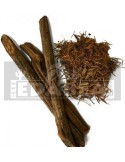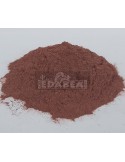Dimethyltryptamine (DMT) Ancestral and contemporary use
Dimethyltryptamine, commonly known as DMT, is a potent psychedelic substance that has been used since ancient times by various indigenous cultures. In recent years, the use of DMT has taken on a new popularity, especially through consumption methods such as combustion and vaping. This article will discuss the traditional and contemporary uses of DMT, exploring its evolution over time and its role in today's society.
First, it is vital to understand what DMT is. It is a naturally occurring alkaloid compound found in numerous plants and animals, known for its intense psychedelic action. DMT is a central component of ayahuasca, a psychedelic brew used in traditional rituals and ceremonies in the Amazon region. When consumed, DMT induces an intense psychedelic experience that some describe as a journey into other dimensions or realities, often laden with symbolism and personal revelations.
The use of DMT and plants containing it dates back thousands of years. Indigenous cultures in Amazonian regions, such as the Shipibo-Conibo and the Ashaninka, have used ayahuasca in spiritual rituals and healing ceremonies for centuries. In their worldview, ayahuasca is a tool for communicating with nature spirits, gaining profound knowledge about the universe and healing both physical and mental illnesses. In many cases, these ceremonies are guided by shamanic guides and healers, respected figures in the communities who possess a deep knowledge of the plants and their medicinal and spiritual uses.
.................
DMT has been found in archaeological artefacts throughout South America, such as 4,000-year-old snorting tubes in Argentina and 2,000-year-old jaguar figurines in Costa Rica. This is evidence that its use was not limited to a single culture or region, and that it has played a key role in rituals and ceremonies since pre-Columbian times.
However, the use of DMT has evolved over time, adapting to modern technologies and customs. In the 1960s, chemist and writer Alexander Shulgin synthesised DMT in a laboratory and documented its effects in detail, opening the door to its popularisation in Western cultures. Although methods of consumption ranged from injections to inhalations, in recent years DMT consumption by combustion and vaping has gained popularity.
These modern methods are generally used with crystallised DMT, which is heated until it vaporises, and then inhaled. For vapers, DMT is diluted in glycerine or propylene glycol and then vaped. This approach has a number of advantages and disadvantages compared to ingesting ayahuasca.
Combustion and vaping can provide a more controlled experience, as the dosage can be accurately measured, and the duration of the trip is much shorter, about 5 to 10 minutes in total. In contrast to the long and sometimes difficult trips induced by ayahuasca, vaporised DMT offers a shorter and more manageable experience. However, the intensity of the experience can be overwhelming and less predictable, which can be unsettling for some users.
...............
Moreover, these modern methods of consumption lack the ceremonial and communal component of the ayahuasca experience, which is important for some users (and, truth be told, not so much for others). In many indigenous cultures, DMT use is seen as a communal rite that connects individuals to each other and to the cosmos. The move towards more individualistic consumption can lead to the loss of these sensations.
It is vital to note that, despite its ancient and contemporary use, DMT is a controlled substance in many countries, which means that its use can be problematic. Furthermore, although some research suggests that it may have therapeutic benefits, such as in the treatment of depression and post-traumatic stress disorder, DMT is a potent substance that can have unpredictable effects and should be used with caution.
Scientifically, DMT is attracting increasing interest for its therapeutic potential. Preliminary studies suggest that it may be useful in the treatment of conditions such as depression, anxiety and post-traumatic stress disorder. It is also being investigated for its ability to induce mystical and spiritual experiences, which could have a positive impact on mental health and well-being. However, research in this field is still young, and more work is needed to fully understand the benefits and risks of DMT.
............
In short, DMT is a fascinating substance with a long history of spiritual and ceremonial use. While its modern use through combustion and vaping may offer a more controlled and accessible experience, it may also alienate users from the ceremonial and communal roots of the DMT experience. As with any psychedelic substance, it should be approached with respect and caution, taking into account both its therapeutic potential and its risks. DMT, in both its traditional and modern forms, remains an object of study and fascination, a window into unsuspected realities and a potential pathway to healing and self-knowledge.
by Neal
Share this content

 (2).jpg)
.jpg)
.jpg)
.jpg)








